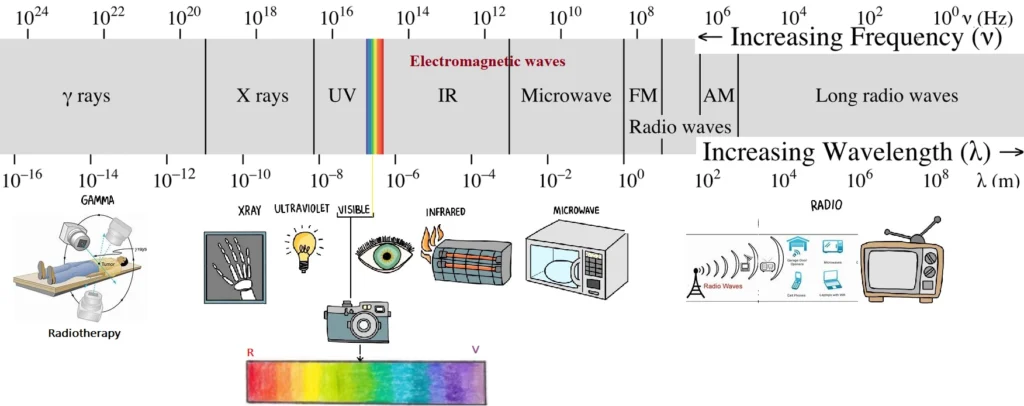Electromagnetic Waves Notes
Hello, readers 😊! In this chapter of 12th-grade physics, you will learn about the properties of electromagnetic waves, conduction current, displacement current, Maxwell’s equations, and Hertz’s experiment.
Wave: A wave is a disturbance produced in a medium that transfers energy and information from one point to another point. For example, sound waves, EM waves, etc.
Electromagnetic Waves
- Electromagnetic Waves are waves that are produced by accelerated charge in which the electric field and magnetic field oscillate perpendicular to each other and also to the direction of propagation of the wave.
- Electromagnetic Waves do not require a medium for their propagation; they can travel in a vacuum.
- The source of an electromagnetic wave is an oscillating charge.
- The frequency of an electromagnetic wave is the same as the frequency of the oscillating charge.

Table of Contents
Electromagnetic Waves INDEX
| 1 | Conduction current and Displacement current |
| 2 | Maxwell’s Equations, Hertz’s experiment |
| 3 | Properties of Electromagnetic Waves, Transverse nature of EM Wave, Electromagnetic spectrum |
Conduction current
The current carried by conductors due to the flow of electrons at a uniform rate. When conduction current flows across a conductor, the electric field remains constant with respect to time.

Displacement current
The current which arises due to changing electric field between plates of capacitor is called displacement current (Id).

Consider a capacitor C is being charged by a battery amount of current flowing through capacitor is I. Draw closed loop S1 and S2 close to capacitor plate. Using Ampere’s circuital law the line integral of magnetic field at S1 is given by

Now apply Ampere’s circuital law for second face S2 of loop, as no conduction current flow between the plates of capacitor so the line integral of magnetic field at S2 should be equal to zero.

Since both loop S1 and S2 are very close to each other so equation 1 should be equal to equation 2, but both are not equal so there is a contradiction arises. This contradiction arises by using Ampere’s circuital law, so Ampere’s circuital seems to be inconsistent in this case i.e. this law must be missing something.
Maxwell’s find this missing term, that there is variable electric field passes through the space between plates of capacitor due to which a current is produced called displacement current.
Time varying electric field between plates of capacitor is given by,

Maxwell modified Ampere’s circuital law as

Properties of Displacement Current:
- Displacement current exists when there is a change of electric flux. Unlike conduction current, it does not exist under steady conditions.
- It is not a current. It only adds to current density in Ampere’s Circuital law. As it produces magnetic field, so called current.
Difference between Conduction Current and Displacement Current.
| Conduction Current | Displacement Current |
|---|---|
| Conduction Current is due to the flow of electrons in a conductor. | Displacement Current is produced due to time-varying electric field. |
| Conduction Current exists even if electrons flow at a uniform rate | Displacement Current does not exist under steady conditions. |
👉🖱 Questions based on Displacement current
👉🖱️ Electromagnetic Waves Important Points – Revision points
MY YouTube Channel Link : 👉🖱 https://www.youtube.com/channel/UCGpC7nWE0-bBv9I53MM8qjQ
Electromagnetic Waves Notes, Electromagnetic Waves Notes, Electromagnetic Waves Notes, Electromagnetic Waves Notes, Electromagnetic Waves Notes, Electromagnetic Waves Notes, Electromagnetic Waves Notes
That’s a very good feedback. I’m curious to think what type of impact this would have globally? There are times when things like this begin to have global expansion and frustration. I’ll check back to see what you have to say.